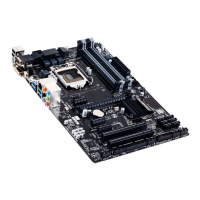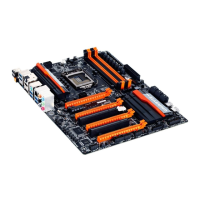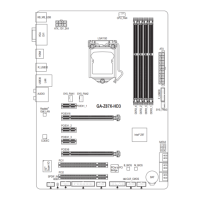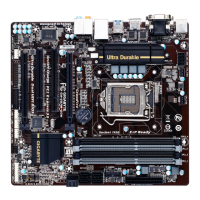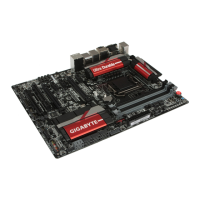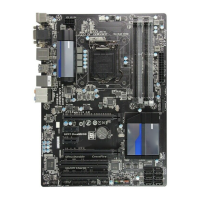
Do you have a question about the Gigabyte GA-Z87-D3HP and is the answer not in the manual?
| ECC | No |
|---|---|
| Non-ECC | Yes |
| Memory voltage | 1.5 V |
| Memory channels | Dual-channel |
| Memory slots type | DIMM |
| Number of memory slots | 4 |
| Supported memory types | DDR3-SDRAM |
| Maximum internal memory | 32 GB |
| Supported memory clock speeds | 1333, 1600 MHz |
| Processor manufacturer | Intel |
| Compatible processor series | Intel Celeron, Intel Pentium |
| Supported processor sockets | LGA 1150 (Socket H3) |
| Maximum number of SMP processors | 1 |
| USB 2.0 connectors | 2 |
| Number of SATA III connectors | 6 |
| Number of Parallel ATA connectors | 0 |
| HDMI version | 1.4a |
| Headphone outputs | 5 |
| USB 2.0 ports quantity | USB 2.0 ports have a data transmission speed of 480 Mbps, and are backwards compatible with USB 1.1 ports. You can connect all kinds of peripheral devices to them. |
| Audio chip | Realtek ALC892 |
| Cooling type | Passive |
| Component for | PC |
| Motherboard chipset | Intel® Z87 |
| PC health monitoring | CPU, FAN, Temperature |
| Audio output channels | 7.1 channels |
| Motherboard form factor | ATX |
| RAID levels | 0, 1, 5, 10 |
| Supported storage drive interfaces | SATA, SATA II, SATA III |
| Graphics card | HD Graphics |
| Maximum resolution | 4096 x 2160 pixels |
| Parallel processing technology support | 2-Way CrossFireX |
| PCI Express slots version | 2.0, 3.0 |
| PCI Express configurations | 1x4, 1x16 |
| Cables included | SATA |
| Ethernet interface type | Gigabit Ethernet |
| BIOS type | EFI AMI |
| ACPI version | 2.0a |
| BIOS memory size | 64 Mbit |
| Depth | 224 mm |
|---|---|
| Width | 305 mm |
Provides copyright details and trademarks.
Outlines manual usage restrictions and GIGABYTE's liability.
Explains different documentation available for the product.
Guides on how to identify the motherboard revision number.
Safety and general guidelines before installing hardware components.
Details CPU, Chipset, Memory, Graphics, Audio, LAN, Expansion Slots, Storage.
Details USB, connectors, I/O controller, and hardware monitoring.
Covers BIOS features, bundled software, OS support, and form factor.
Guides on installing the CPU and CPU cooler with precautions.
Step-by-step instructions for installing the CPU into the socket.
Detailed steps for mounting the CPU cooler onto the motherboard.
Guidelines for installing memory and understanding Dual Channel configuration.
Step-by-step guide on how to properly insert memory modules into sockets.
Procedures for installing expansion cards like graphics cards into slots.
Describes USB, display (D-Sub, DVI-D, HDMI) ports.
Details LAN, audio jacks, and multi-display support.
Overview of internal headers and connectors on the motherboard.
Details ATX 12V and 2x12 main power connectors and their pinouts.
Details the 4-pin fan headers for CPU and system cooling.
Covers SATA connectors and CMOS battery.
Instructions on how to clear CMOS values.
Explains front panel headers for chassis connections.
Details front panel audio and SPDIF In headers.
Details S/PDIF Out connector and USB 2.0/1.1 headers.
Details USB 3.0/2.0 headers and the COM serial port header.
Information on connecting a Trusted Platform Module.
Explains BIOS functions, access, and upgrade utilities like Q-Flash and @BIOS.
Describes the initial boot screen and the function keys for BIOS navigation.
Details the main BIOS menu structure and navigation keys.
Overview of the different BIOS setup menus and their purposes.
Introduces the M.I.T. section for CPU/memory tuning and system monitoring.
Options for adjusting CPU, PCIe, and memory frequencies and clocks.
Configuration for CPU core features like PLL, Turbo Boost, and power limits.
Settings related to CPU current limits, core enabling, thermal monitoring, and EIST.
Options for configuring memory profiles, performance, timings, and voltages.
Detailed memory timing adjustments and voltage controls.
Settings for CPU VRIN loadline calibration, protection, and PWM controls.
Configuration for PWM switch rates, phase control, and voltage controls.
Monitors system voltages, temperatures, fan speeds, and case intrusion status.
Details system temperatures, fan speed controls, and warning settings.
Configuration for PCIe slot modes and legacy benchmark enhancement.
Displays system information and allows setting BIOS language and system time.
Defines the boot device order and options for UEFI/Legacy boot.
Configures boot order, NumLock, passwords, and boot logo.
Settings for OS type, CSM support, boot modes, and PCI device ROM priority.
Sets administrator and user passwords for BIOS access.
Configuration for onboard LAN and USB controller modes (XHCI).
Settings for onboard audio, display initialization, internal graphics, and USB support.
Configuration for SATA controllers, modes (IDE/RAID/AHCI), ports, and serial port.
Configuration options for the Intel Ethernet Connection i217.
Configures system power-on by alarm, wake-on-LAN, ErP mode, and AC power loss.
Options to power on the system using keyboard or mouse, including password protection.
Options to save/exit, exit without saving, load default settings, and boot overrides.
Details minimum drive requirements and array capacities for RAID levels.
Steps to set SATA controller mode (IDE, AHCI, RAID) in BIOS.
Instructions for configuring UEFI RAID mode for Windows 8.
Steps to create a RAID volume, select disks, and set stripe block size in UEFI mode.
Completing RAID volume creation and viewing details in UEFI mode.
Procedure to delete a RAID array in UEFI mode.
Steps to configure RAID arrays using the legacy RAID ROM utility.
Steps to create a RAID volume, select disks, and set stripe block size in Legacy mode.
Completing RAID volume creation and viewing details in Legacy mode.
Details on setting up and using Recovery Volume for data protection.
Settings for continuous or on-request synchronization for recovery volumes.
Procedures for deleting RAID volumes and managing acceleration options.
Guide to installing Windows 8/7 and loading necessary SATA RAID/AHCI drivers.
Process for rebuilding fault-tolerant RAID arrays (RAID 1, 5, 10).
Steps to perform RAID rebuild using the Intel Rapid Storage Technology utility.
How to restore master drive data from a recovery volume.
Instructions for installing chipset drivers using the GIGABYTE driver disk.
Details on installing GIGABYTE applications and driver information.
Introduction to BIOS update tools like Q-Flash and @BIOS, and DualBIOS technology.
Step-by-step guide to update BIOS using the Q-Flash utility.
Recommends loading BIOS defaults after a BIOS update.
Instructions for updating BIOS using the @BIOS utility in Windows.
How to launch and use the GIGABYTE APP Center for software management.
Details on using EasyTune for system tuning, overclocking, and fan control.
How to switch hard drive operating modes (IDE, AHCI, RAID) using EZ Setup.
Steps for configuring Intel Smart Response Technology for SSD caching.
Guide to setting up Intel Rapid Start Technology for faster system startup.
How to use EZ Smart Connect for automatic app updates via the internet.
Quick RAID 0/1 configuration for enhanced hard drive performance.
How to block specific USB device types on the PC.
Setting up 2, 4, 5.1, or 7.1 channel audio configurations.
Configuring sound effects, AC'97 modules, and muting back panel audio.
Connecting and configuring the S/PDIF In port for digital audio input.
Connecting and configuring the S/PDIF Out port for digital audio output.
Steps to connect and configure microphone for recording audio.
How to use Sound Recorder and enable Stereo Mix for audio recording.
Basic operations for recording and playing audio files using Sound Recorder.
Answers to common questions regarding system behavior and troubleshooting.
A flowchart to diagnose and solve system startup issues.
Legal notices and disclaimers regarding document usage and GIGABYTE's liability.
Lists contact details for GIGABYTE offices worldwide.

